Grout Ground Leakage Caused by the Development of Separation Layer in a Case Study of Muduchaideng Coal Mine
Abstract
1. Introduction
2. Materials and Methods
2.1. The Study Area
2.1.1. Mining Conditions
2.1.2. Adaptability of Separation Layer Grouting
2.2. Indoor Scale Model Experiment
2.2.1. Scale Model Establishment
2.2.2. PIV
2.3. Field Measurement
3. Results and Analysis
3.1. Development Characteristics of Separation Layer
3.2. Mud Slurry Consumption and Water Level during Drilling
3.3. Borehole Damage at the Locations of Laminated Fracture Development Layers
4. Discussion
4.1. Separation Layer Grout Position Selection
4.2. Impact of Mining on Borehole Integrity
4.3. Mechanism of the Grout Ground Leakage in Muduchaideng Coal Mine
5. Conclusions
- This study revealed the mechanism of grout ground leakage caused by the development of separation layers during mining in a case study of Muduchaideng coal mine. The conclusions are as follows:
- Through laboratory experiments and field drilling verification, the position of the separation layer at the Muduchaideng coal mine was validated at the depths of 289.67–322.48 m, 386.42–431.18 m, and 474.95–524.07 m. These positions are above the grout layer and the borehole wall was seriously disturbed.
- A mechanism of grout ground leakage was proposed. The position of the separation layer develops upwards due to poor settlement control. The development of separation will result in borehole integrity damage, which will further lead to breaks in the grout pipeline. Then, the grout will backflow along the borehole walls to the surface, eventually resulting in surface slurry leakage.
- This study has implications for providing a warning to prevent grout ground leakage.
Author Contributions
Funding
Data Availability Statement
Conflicts of Interest
References
- Cheng, G.W.; Ma, T.H.; Tang, C.N.; Liu, H.Y.; Wang, S.J. A zoning model for coal mining-induced strata movement based on microseismic monitoring. Int. J. Rock. Mech. Min. Sci. 2017, 94, 123–138. [Google Scholar] [CrossRef]
- Chen, L.W.; Feng, X.Q.; Xie, W.P.; Xu, D.Q. Prediction of water-inrush risk areas in process of mining under the unconsolidated and confined aquifer: A case stud from the Qidong coal mine in China. Environ. Earth Sci. 2016, 75, 706. [Google Scholar] [CrossRef]
- He, J.H.; Li, W.P.; Fan, K.; Qiao, W.; Wang, Q.; Li, L. A method for predicting the water-flowing fractured zone height based on an improved key stratum theory. Int. J. Min. Sci. Technol. 2023, 33, 61–71. [Google Scholar] [CrossRef]
- He, J.H.; Li, W.P.; Liu, Y.; Yang, Z.; Liu, S.L.; Li, L.F. An improved method for determining the position of overlying separated strata in mining. Eng. Fail. Anal. 2018, 83, 17–29. [Google Scholar] [CrossRef]
- Majdi, A.; Hassani, F.P.; Nasiri, M.Y. Prediction of the height of destressed zone above the mined panel roof in longwall coal mining. Int. J. Coal Geol. 2012, 98, 62–72. [Google Scholar] [CrossRef]
- Das, S.K. Observations and classification of roof strata behaviour over longwall coal mining panels in India. Int. J. Rock. Mech. Min. Sci. 2000, 37, 585–597. [Google Scholar] [CrossRef]
- Meng, Z.P.; Shi, X.C.; Li, G.Q. Deformation, failure and permeability of coal-bearing strata during longwall mining. Eng. Geol. 2016, 208, 69–80. [Google Scholar] [CrossRef]
- Mark, C.; Molinda, G.M. Coal mine roof rating: A decade of experience. Int. J. Coal Geol. 2005, 64, 85–103. [Google Scholar] [CrossRef]
- Xuan, D.; Xu, J.; Wang, B. Borehole Investigation of the Effectiveness of Grout Injection Technology on Coal Mine Subsidence Control. Rock. Mech. Rock. Eng. 2015, 48, 2435–2445. [Google Scholar] [CrossRef]
- Xu, J.; Xuan, D. Cost Investigation of the Coalmine Subsidence Control Technology of Isolated Overburden Grout Injection. Geotech. Geol. Eng. 2019, 37, 4251–4258. [Google Scholar] [CrossRef]
- Wang, B.; Xu, J.; Xuan, D. Time function model of dynamic surface subsidence assessment of grout-injected overburden of a coal mine. Int. J. Rock. Mech. Min. Sci. 2018, 104, 1–8. [Google Scholar] [CrossRef]
- Zou, L.; Håkansson, U.; Cvetkovic, V. Analysis of Bingham fluid radial flow in smooth fractures. J. Rock. Mech. Geotech. 2020, 12, 1112–1118. [Google Scholar] [CrossRef]
- Xuan, D.; Li, J.; Zheng, K. Experimental Study of Slurry Flow in Mining-Induced Fractures during Longwall Overburden Grout Injection. Geofluids 2020, 2020, 8877616. [Google Scholar] [CrossRef]
- Jin, L.; Sui, W. Experimental investigation on chemical grouting in rough 2D fracture network with flowing water. Bull. Eng. Geol. Environ. 2021, 80, 8519–8533. [Google Scholar] [CrossRef]
- Sui, W. Experimental investigation on sealing efficiency of chemical grouting in rock fracture with flowing water. Tunn. Undergr. Space Technol. 2015, 50, 239–249. [Google Scholar] [CrossRef]
- Jin, L.; Sui, W. Experimental Investigation on Chemical Grouting in a Permeated Fracture Replica with Different Roughness. Appl. Sci. 2019, 9, 2762. [Google Scholar] [CrossRef]
- He, S.; Lai, J.; Wang, L.; Wang, K. A literature review on properties and applications of grouts for shield tunnel. Constr. Build. Mater. 2020, 239, 117782. [Google Scholar] [CrossRef]
- Jiang, C.; Wang, Y.; Duan, M.; Guo, X.; Chen, Y.; Yang, Y. Experimental study on the evolution of pore-fracture structures and mechanism of permeability enhancement in coal under cyclic thermal shock. Fuel 2021, 304, 121455. [Google Scholar] [CrossRef]
- Jin, Y.; Han, L.; Xu, C.; Meng, Q.; Zong, Y. Cement Grout Nonlinear Flow Behavior through the Rough-Walled Fractures: An Experimental Study. Geofluids 2020, 2020, 9514691. [Google Scholar] [CrossRef]
- Zhang, G.L. Mechanism of deflection propagation for grouting in fractured rock mass with flowing water and mining effect on grouted curtain: A review. J. Eng. Geol. 2022, 30, 987–997, (In Chinese, Abstract in English). [Google Scholar]
- Jiang, X.; Zheng, G.; Sui, W. Anisotropic propagation of chemical grouting in fracture network with flowing water. ACS Omega 2021, 6, 4672–4679. [Google Scholar] [CrossRef]
- Zheng, G.; Sui, W.; Zhang, G. Propagation and sealing efficiency of chemical grouting in a two-dimensional fracture network with flowing water. Int. J. Min. Sci. Technol. 2023, 33, 903–917. [Google Scholar] [CrossRef]
- Wang, Y.; Yang, P.; Li, Z.; Wu, S.; Zhao, Z. Experimental-numerical investigation on grout diffusion and washout in rough rock fractures under flowing water. Comput. Geotech. 2020, 126, 103717. [Google Scholar] [CrossRef]
- Yan, C.; Tong, Y.; Luo, Z.; Ke, W.; Wang, G. A two-dimensional grouting model considering hydromechanical coupling and fracturing for fractured rock mass. Eng. Anal. Bound. Elem. 2021, 133, 385–397. [Google Scholar] [CrossRef]
- Kou, T.; Wen, S.; Mu, W.; Xu, N.; Gao, Z.; Lin, Z.; Liu, H. Slurry leakage channel detection and slurry transport process simulation for overburden bed separation grouting project: A case study from the wuyang coal mine, northern China. Water 2023, 15, 996. [Google Scholar] [CrossRef]
- Zhang, Z.J. Overburden abscission layer spatial-temporal evolution pattern and grouting mining practice—A case study of 3117 working face in Xiadian coal mine. Coal Geol. China 2023, 35, 33–40, (In Chinese, Abstract in English). [Google Scholar]
- Xu, L.J.; Zhang, K.; Liu, X.P. Deformation characteristic of key strata and control effect of surface subsidence in mining with grouting into overburden bed-separation. J. China Coal Soc. 2023, 48, 931–942, (In Chinese, Abstract in English). [Google Scholar]
- Wang, K. Development status of technology studies of grouting into overburden bed-separation of coal mine in China. Coal Technol. 2016, 35, 42–44, (In Chinese, Abstract in English). [Google Scholar]
- Yao, W.T.; Kou, T.H.; Fan, B. Influence evaluation of mining-induced strata separation grouting on mine safety. Coal Technol. 2022, 41, 170–174, (In Chinese, Abstract in English). [Google Scholar]
- Liu, J.; Sui, W.; Zhao, Q. Environmentally sustainable mining: A case study of intermittent cut-and-fill mining under sand aquifers. Environ. Earth Sci. 2017, 76, 562. [Google Scholar] [CrossRef]
- White, D.J.; Take, W.A.; Bolton, M.D. Soil deformation measurement using particle image velocimetry (PIV) and photogrammetry. Geotechnique 2003, 53, 619–631. [Google Scholar] [CrossRef]
- Bi, Z.Q.; Gong, Q.M.; Guo, P.J.; Chen, Q. Experimental study of the evolution of soil arching effect under cyclic loading based on trapdoor test and particle image velocimetry. Can. Geotech. J. 2020, 57, 903–920. [Google Scholar] [CrossRef]
- Khatami, H.; Deng, A.; Jaksa, M. The arching effect in rubber–sand mixtures. Geosynth. Int. 2020, 4, 432–450. [Google Scholar] [CrossRef]
- Zhao, Y.; Gong, Q.M.; Wu, Y.J.; Tian, Z.Y.; Zhou, S.H.; Fu, L.L. Progressive failure mechanism in granular materials subjected to an alternant active and passive trapdoor. Transp. Geotech. 2021, 28, 100529. [Google Scholar] [CrossRef]
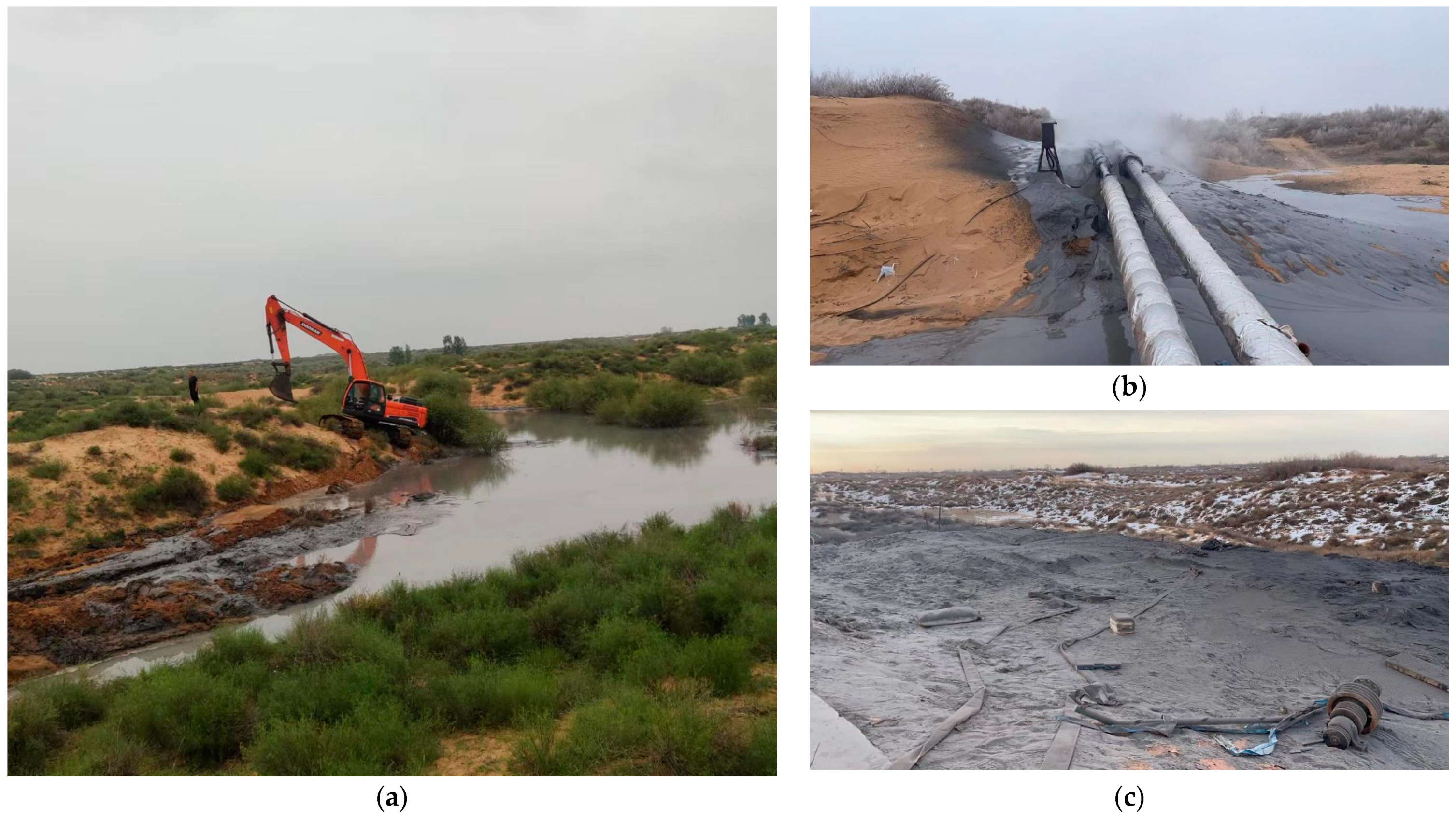


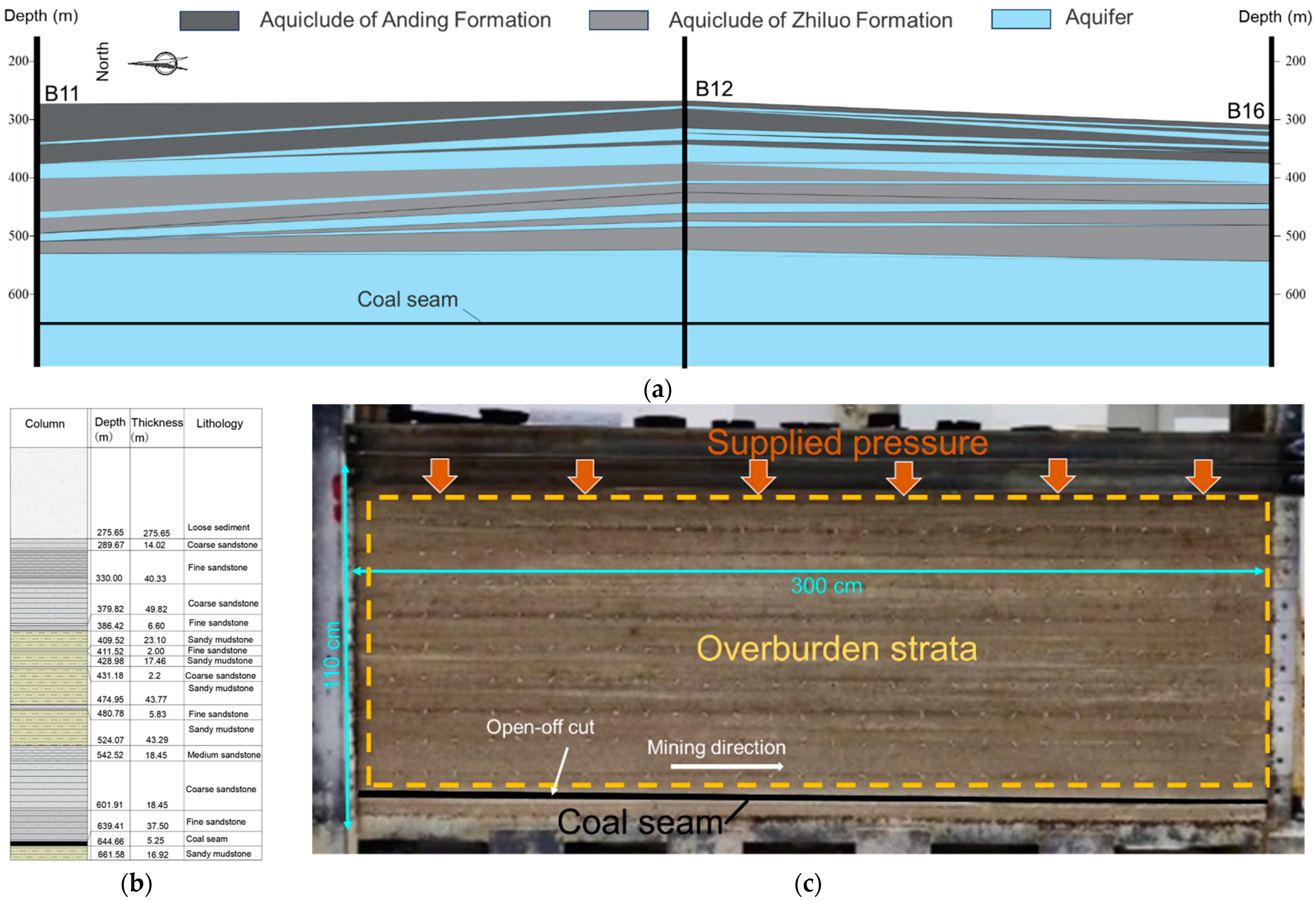
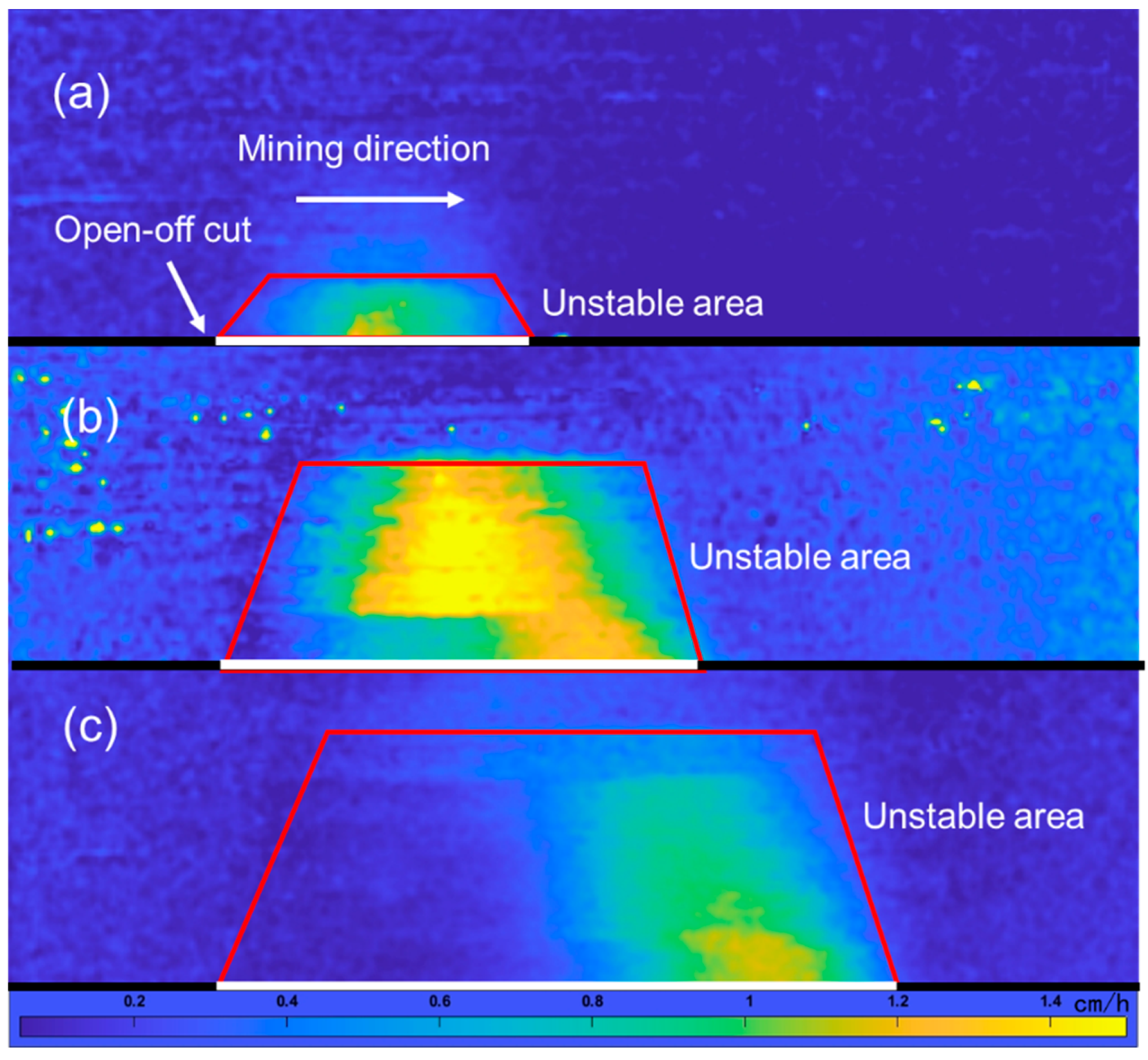

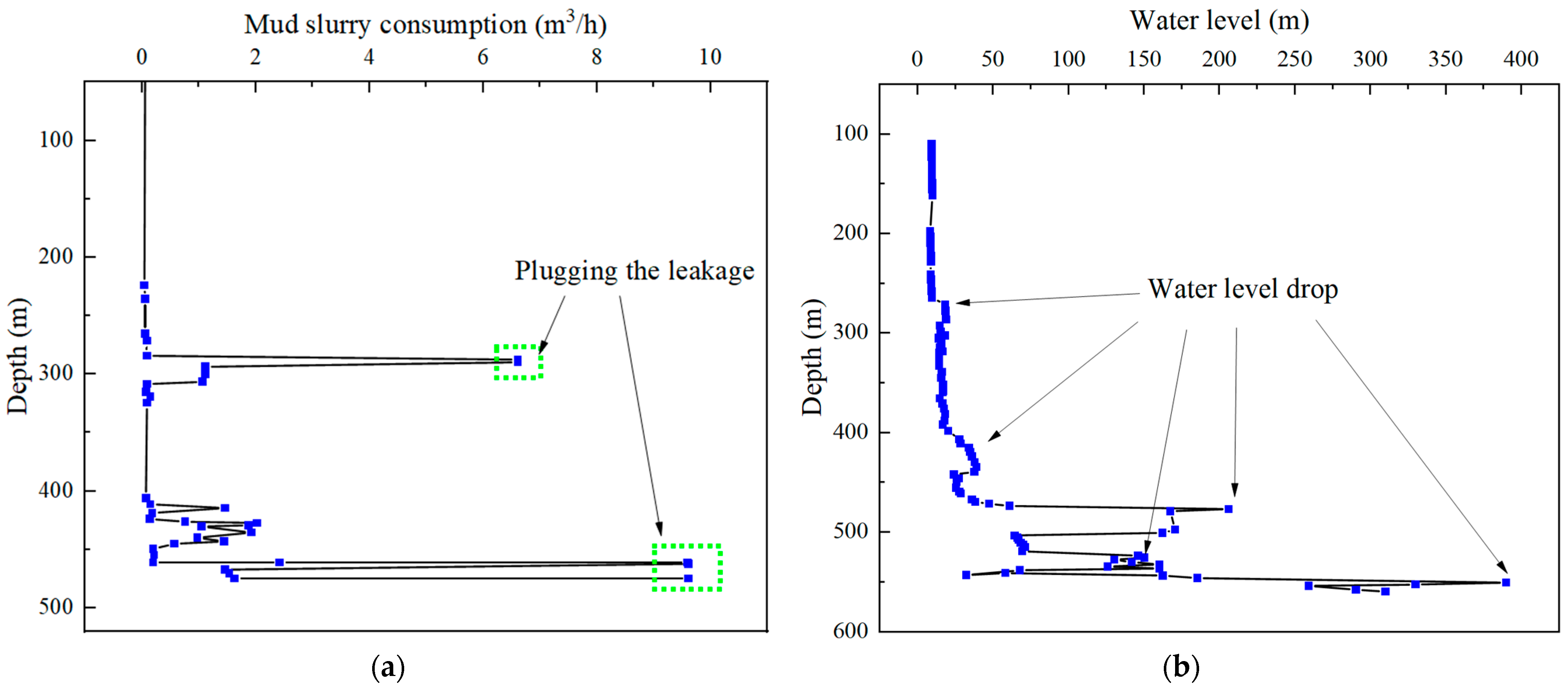
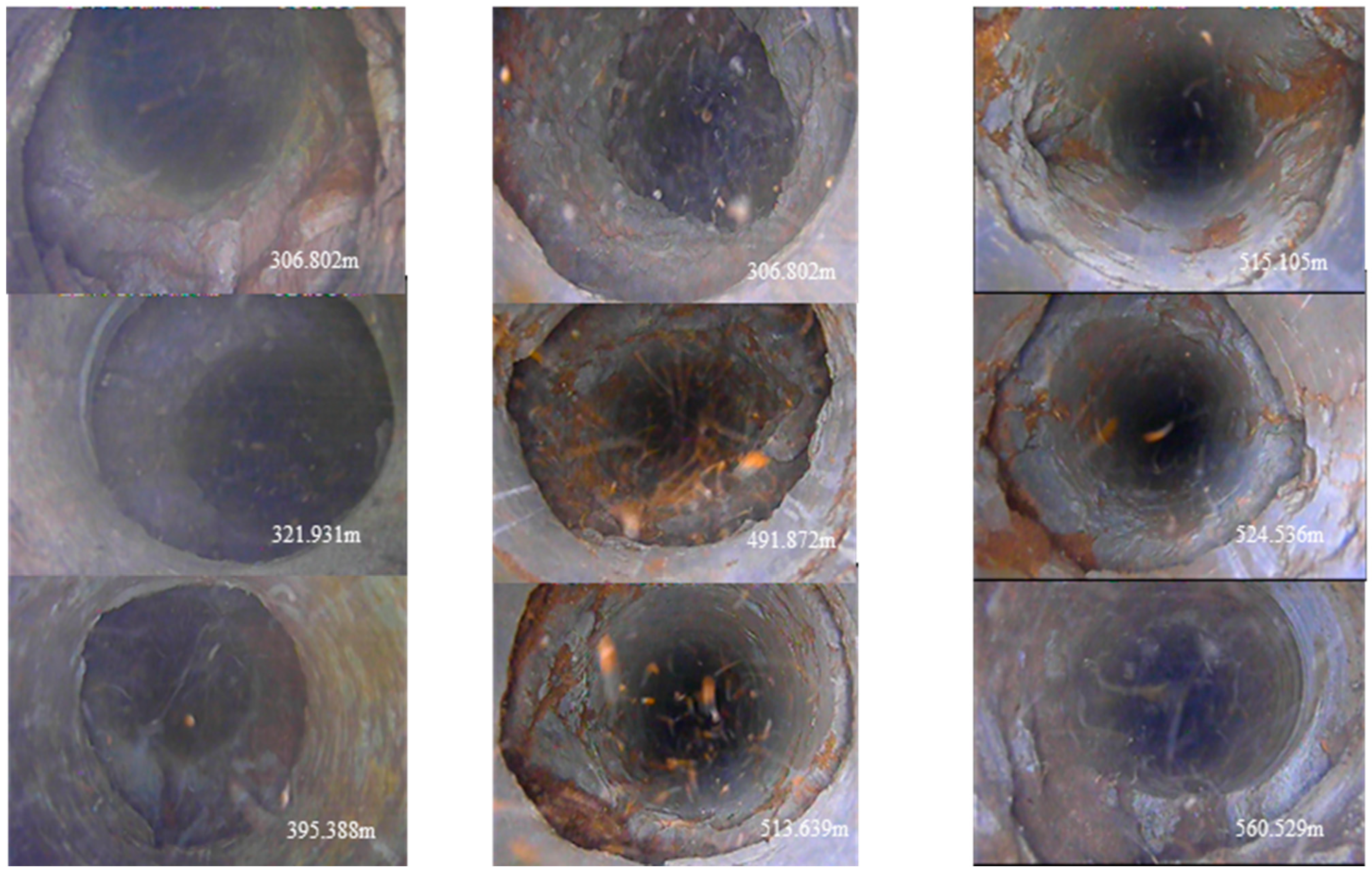

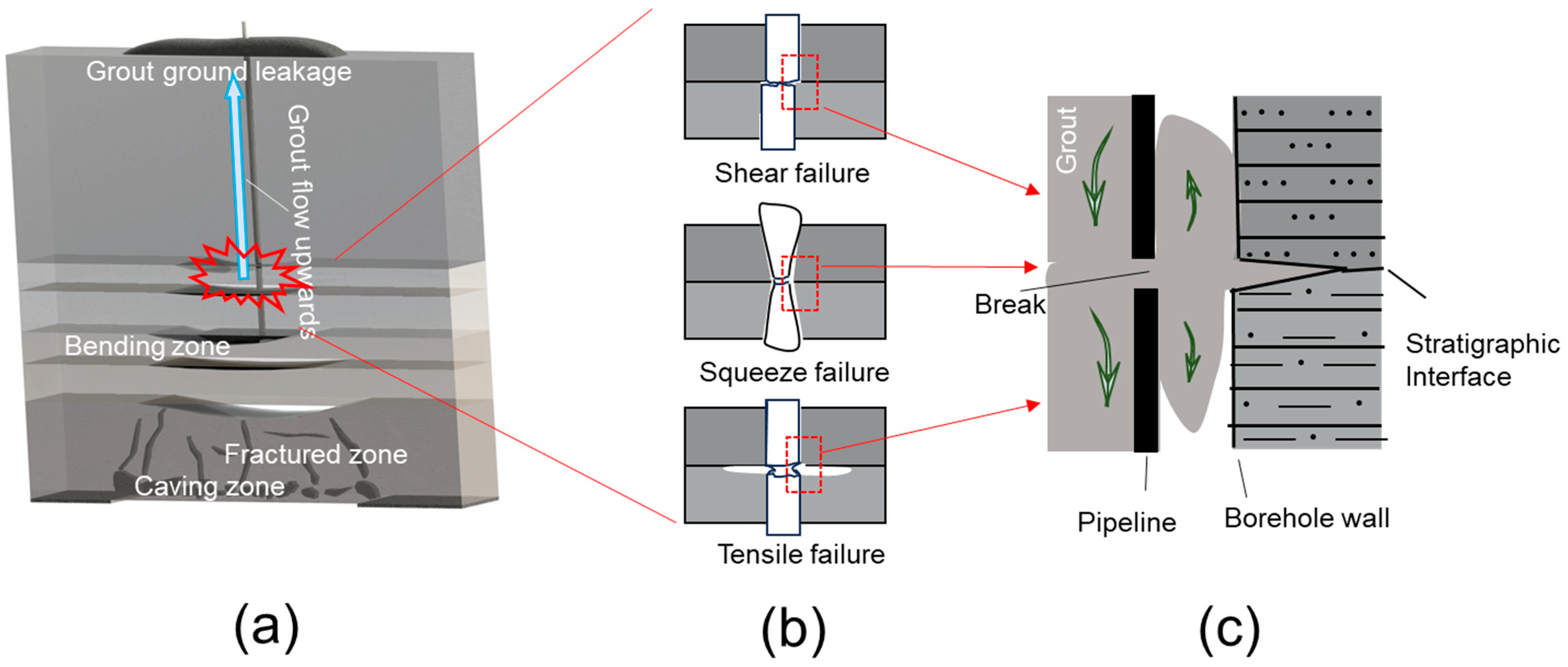
| Factors | Adaptation Conditions | Muduchaideng Coal Mine Conditions |
|---|---|---|
| Strata structure | Interbeds | Interbedding of sandstone, sandy mudstone and mudstone |
| Lithology | Large difference in hardness | Large difference in hardness |
| Geological structure | No fault | No fault |
| Mining method | Fully mechanized mining and complete collapse in longwall panel | Fully mechanized mining and complete collapse in longwall panel |
| Coal seam occurrence | Horizontal or gently inclined coal seam | Angle 1–3° |
| Geometry Ratio | Density Ratio | Strength Ratio | Time Ratio |
|---|---|---|---|
| 1:500 | 1:1.67 | 1:835 | 1:22.36 |
| Failure Type of the Pipeline | Cause |
|---|---|
| Shear failure | Strata slide along the interface, pipeline is subjected to radial force, resulting in shear failure |
| Squeeze failure | The pipeline yields and deforms under the pressure of the formation. |
| Tensile failure | Separation layer develops and the pipeline is stretched; obvious tensile deformation occurs at this position. |
Disclaimer/Publisher’s Note: The statements, opinions and data contained in all publications are solely those of the individual author(s) and contributor(s) and not of MDPI and/or the editor(s). MDPI and/or the editor(s) disclaim responsibility for any injury to people or property resulting from any ideas, methods, instructions or products referred to in the content. |
© 2024 by the authors. Licensee MDPI, Basel, Switzerland. This article is an open access article distributed under the terms and conditions of the Creative Commons Attribution (CC BY) license (https://creativecommons.org/licenses/by/4.0/).
Share and Cite
Xie, B.; Meng, X.; Sui, W.; Hang, Y.; Yuan, S. Grout Ground Leakage Caused by the Development of Separation Layer in a Case Study of Muduchaideng Coal Mine. Water 2024, 16, 211. https://doi.org/10.3390/w16020211
Xie B, Meng X, Sui W, Hang Y, Yuan S. Grout Ground Leakage Caused by the Development of Separation Layer in a Case Study of Muduchaideng Coal Mine. Water. 2024; 16(2):211. https://doi.org/10.3390/w16020211
Chicago/Turabian StyleXie, Baolei, Xiangdong Meng, Wanghua Sui, Yuan Hang, and Shichong Yuan. 2024. "Grout Ground Leakage Caused by the Development of Separation Layer in a Case Study of Muduchaideng Coal Mine" Water 16, no. 2: 211. https://doi.org/10.3390/w16020211
APA StyleXie, B., Meng, X., Sui, W., Hang, Y., & Yuan, S. (2024). Grout Ground Leakage Caused by the Development of Separation Layer in a Case Study of Muduchaideng Coal Mine. Water, 16(2), 211. https://doi.org/10.3390/w16020211






